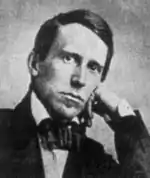Stephen Foster
Stephen Collins Foster (July 4, 1826 – January 13, 1864), known also as "the father of American music", was an American songwriter known primarily for his parlor and minstrel music. He wrote more than 200 songs, including "Oh! Susanna", "Hard Times Come Again No More", "Camptown Races", "Old Folks at Home" ("Swanee River"), "My Old Kentucky Home", "Jeanie with the Light Brown Hair", "Old Black Joe", and "Beautiful Dreamer", and many of his compositions remain popular today. He has been identified as "the most famous songwriter of the nineteenth century" and may be the most recognizable American composer in other countries.[4] Most of his handwritten music manuscripts are lost, but editions issued by publishers of his day feature in various collections.[5]
Stephen Foster | |
|---|---|
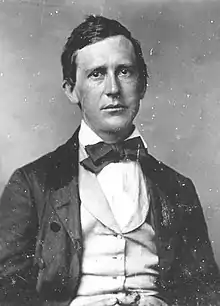 | |
| Born | Stephen Collins Foster July 4, 1826 Lawrenceville, Pennsylvania, U.S. |
| Died | January 13, 1864 (aged 37) New York City, New York, U.S. |
| Resting place | Allegheny Cemetery Pittsburgh, Pennsylvania, U.S. |
| Monuments | Stephen Foster Memorial Pittsburgh, Pennsylvania, U.S. |
| Education | Athens Academy, Towanda, Pennsylvania Athens Academy |
| Occupation | Composer, lyricist, poet[1] |
| Years active | 1844–1864 |
| Agent | Various sheet music publishers and brother, Morrison Foster |
| Known for | First fully professional U.S. songwriter[2][3] |
Notable work | "Angelina Baker", "Beautiful Dreamer", "Camptown Races", "Gentle Annie", "The Glendy Burk", "Hard Times Come Again No More", "Jeanie with the Light Brown Hair", "My Old Kentucky Home", "Oh! Susanna", "Old Black Joe", "Old Folks at Home" ("Swanee River"), "Open Thy Lattice Love" |
| Style | Period music, minstrel |
| Spouse(s) | Jane McDowell Foster Wiley (1829–1903) (other sources use Jane Denny Foster Wiley)[1] |
| Children | Marion Foster Welch (1851–1935) |
| Parent(s) | William Barclay Foster (1779–1855), Eliza Clayland Tomlinson Foster (1788–1855) |
| Relatives | Evelyn Foster Morneweck (niece and biographer), James Foster (grandfather) Siblings:Charlotte Susanna Foster (1809–1829), Anne Eliza Foster Buchanan (1812–1891), Henry Baldwin Foster (1816–1870), Henrietta Angelica Foster Thornton (1819–1879), Dunning McNair Foster (1821–1856), Morrison Foster (1823–1904) |
Biography

There are many biographies of Foster, but details differ widely. Among other issues, Foster wrote very little biographical information himself, and his brother Morrison Foster destroyed much information that he judged to reflect negatively upon the family.[6][7]
Foster was born on July 4, 1826,[8] to William Barclay Foster and Eliza Clayland Tomlinson Foster, with three older sisters and six older brothers. His parents were of Ulster Scots and English descent. He attended private academies in Allegheny, Athens, and Towanda, Pennsylvania and received an education in English grammar, diction, the classics, penmanship, Latin, Greek, and mathematics. The family lived in a northern city but they did not support the abolition of slavery.[8]
Foster taught himself to play the clarinet, guitar, flute, and piano. He did not have formal instruction in composition but he was helped by Henry Kleber (1816–97), a German-born music dealer in Pittsburgh.[9] In 1839, his brother William was serving his apprenticeship as an engineer at Towanda and thought that Stephen would benefit from being under his supervision. The site of the Camptown Races is 30 miles (48 km) from Athens and 15 miles from Towanda. His education included a brief period at Jefferson College in Washington, Pennsylvania, now Washington & Jefferson College.[10][nb 1] His tuition was paid, but he had little spending money.[10] He left Canonsburg to visit Pittsburgh with another student and did not return.[10]
Career
In 1846, Foster moved to Cincinnati, Ohio, and became a bookkeeper with his brother Dunning's steamship company. He wrote his first successful songs in 1848–1849, among them "Oh! Susanna",[12] which became an anthem of the California Gold Rush. In 1849, he published Foster's Ethiopian Melodies, which included the successful song "Nelly Was a Lady" as made famous by the Christy Minstrels. A plaque marks the site of his residence in Cincinnati, where the Guilford School building is now located.

Then he returned to Pennsylvania and signed a contract with the Christy Minstrels. It was during this period that he wrote most of his best-known songs: "Camptown Races" (1850), "Nelly Bly" (1850), "Ring de Banjo" (1851), "Old Folks at Home" (known also as "Swanee River", 1851), "My Old Kentucky Home" (1853), "Old Dog Tray" (1853), and "Jeanie with the Light Brown Hair" (1854), written for his wife Jane Denny McDowell.
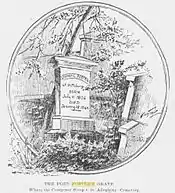
Many of Foster's songs were of the blackface minstrel show tradition popular at the time but now recognized as racist. He sought to "build up taste...among refined people by making words suitable to their taste, instead of the trashy and really offensive words which belong to some songs of that order".[14] In the 1850s, he associated with a Pittsburgh-area abolitionist leader named Charles Shiras, and wrote an abolitionist play himself.[15] Many of his songs had Southern themes, yet Foster never lived in the South and visited it only once, during his 1852 honeymoon.
Foster's last four years were spent in New York City. There is little information on this period of his life, although family correspondence has been preserved.[5]
Illness and death
Foster got sick with a fever in January 1864. Weakened, he fell in his hotel in the Bowery, cutting his neck. His writing partner George Cooper found him still alive but lying in a pool of blood. Foster died in Bellevue Hospital three days later at the age of 37.[16] Other biographers describe different accounts of his death.[17]
Historian JoAnne O’Connell speculates in her biography, The Life and Songs of Stephen Foster, that Foster may have killed himself, a common occurrence during the Civil War.[18] George Cooper, who was with Foster until he died, said: “He lay there on the floor, naked, suffering horribly. He had wonderful big brown eyes, and they looked up at me with an appeal I can never forget. He whispered, ‘I’m done for.’” Unlike Foster’s brother Morrison, who was not in New York and said Foster was ill and cut his neck on a washbasin, Cooper mentioned no broken crockery and also said Foster had a “large knife” for cutting up apples and turnips. Morrison may have covered up Foster’s suicide. Evelyn Morneweck, Morrison’s daughter, also said the family would have covered up the suicide of their uncle if they could have.
As O’Connell and musicologist Ken Emerson have noted, several of the songs Foster wrote during the last years of his life foreshadow his death, such as “The Little Ballad Girl” and “Kiss Me Dear Mother Ere I Die.”Emerson says in his 2010 Stephen Foster and Co. that Foster’s injuries may have been “accidental or self-inflicted.”[19]
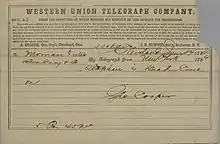
When Foster died, his leather wallet contained a scrap of paper that simply said, "Dear friends and gentle hearts", along with 38 cents (one for each year of his life) in Civil War scrip and three pennies. The note is said to have inspired Bob Hilliard's lyric for "Dear Hearts and Gentle People" (1949). Foster was buried in the Allegheny Cemetery in Pittsburgh. After his death, Morrison Foster became his "literary executor". As such, he answered requests for copies of manuscripts, autographs, and biographical information.[5] One of the best-loved of his works was "Beautiful Dreamer", published shortly after his death.[20]
Music
Foster grew up in a section of the city where many European immigrants had settled and was accustomed to hearing the music of the Italian, Scots-Irish, and German residents. He composed his first song when he was 14 and entitled it the "Tioga Waltz". The first song that he had published was "Open thy Lattice Love" (1844).[9][21] He wrote songs in support of drinking, such as "My Wife Is a Most Knowing Woman", "Mr. and Mrs. Brown", and "When the Bowl Goes Round", while also composing temperance songs such as "Comrades Fill No Glass for Me" or "The Wife".[8] Foster also authored many church hymns, although the inclusion of his hymns in hymnals ended by 1910. Some of the hymns are "Seek and ye shall find",[22] "All around is bright and fair, While we work for Jesus",[23] and "Blame not those who weep and sigh".[24] Several rare Civil War-era hymns by Foster were performed by The Old Stoughton Musical Society Chorus, including "The Pure, The Bright, The Beautiful", "Over The River", "Give Us This Day", and "What Shall The Harvest Be?"
Foster usually sent his handwritten scores directly to his publishers. The publishers kept the sheet music manuscripts and did not give them to libraries nor return them to his heirs. Some of his original, hand-written scores were bought and put into private collections and the Library of Congress.[5]
Popular songs
Foster's songs, lyrics, and melodies have often been altered by publishers and performers.[25] Ray Charles released a version of "Old Folks at Home" that was titled "Swanee River Rock (Talkin’ ’Bout That River)," which became his first pop hit in November 1957.[26]
"My Old Kentucky Home" is the official state song of Kentucky, adopted by the General Assembly on March 19, 1928. "Old Folks at Home" became the official state song of Florida, designated in 1935.[27] The lyrics are widely regarded as racist today, however, so "Old Folks at Home" was modified with approval from the Stephen Foster Memorial. The modified song was kept as the official state song, while "Florida (Where the Sawgrass Meets the Sky)" was added as the state anthem.
Critics and controversies
From a modern perspective Foster's compositions can be seen as disparaging to African Americans, or outright racist. Others have argued that Foster unveiled the realities of slavery in his work while also imparting some dignity to African Americans in his compositions, especially as he grew as an artist.[28] Foster composed many songs that were used in minstrel shows. This form of public entertainment lampooned African Americans as buffoonish, superstitious, without a care, musical, lazy, and dim-witted.[29][30] In the early 1830s, these minstrel shows gained popularity, and blackface minstrel shows were a separate musical art form by 1848, more readily accessible to the general public than opera.[31]
Greenfield Village and the Henry Ford Museum
In 1935, Henry Ford ceremonially presented a new addition to his historical collection of early American memorabilia in the "Home of Stephen Foster". The structure was identified by notable historians of the time as being authentic and was then deconstructed and moved "piece by piece" from Lawrenceville, Pennsylvania (now part of Pittsburgh), to Greenfield Village, attached to the Henry Ford Museum, in Dearborn, Michigan. Foster's niece insisted that it was not his birthplace, and the claim was withdrawn in 1953. Greenfield Village still displays a structure that is identified as the birthplace of Stephen Foster.[32] The Foster family stated that the original Foster birthplace structure was torn down in 1865.[33][34]
Legacy
Musical influence
- Many early filmmakers selected Foster's songs for their work because his copyrights had expired and cost them nothing.[35]
- Professor of Folklore and musician John Minton wrote a song titled "Stephen C. Foster's Blues".[36]
- Erika M. Anderson, of the band EMA, refers to Foster's "Camptown Races" in the song "California", from past Life Martyred Saints (2011): "I bet my money on the bobtail nag/somebody bet on the bay."[37]
- The Firesign Theatre makes many references to Foster's compositions in their CD, Boom Dot Bust (1999, Rhino Records)
- Larry Kirwan of Black 47 mixes the music of Foster with his own in the musical Hard Times, which earned a New York Times accolade in its original run: "a knockout entertainment". Kirwan gives a contemporary interpretation of Foster's troubled later years and sets it in the tumultuous time of the New York draft riots and the Irish–Negro relations of the period. A revival ran at the Cell Theater in New York in early 2014, and a revised version of the musical, called Paradise Square opened at Berkeley Repertory Theatre in 2018.
- Gordon Lightfoot wrote a song in 1970 titled "Your Love's Return (Song for Stephen Foster)"
- Spike Jones recorded a comedy send-up "I Dream of Brownie in the Light Blue Jeans."
- Humorist Stan Freberg imagined a 1950s style version of Foster's music in "Rock Around Stephen Foster" and, with Harry Shearer, had a sketch about Foster having writer's block in a bit from his "United States of America" project.
- Songwriter Tom Shaner mentions Stephen Foster meeting up with Eminem's alter ego "Slim Shady" on the Bowery in Shaner's song "Rock & Roll is A Natural Thing."
- The music of Stephen Foster was an early influence on the Australian composer Percy Grainger, who stated that hearing "Camptown Races" sung by his mother was one of his earliest musical recollections. He went on to write a piece entitled "Tribute to Foster," a composition for mixed choir, orchestra, and pitched wine glasses based on the melody of "Camptown Races."[38]
- Art Garfunkel was cast as Stephen Foster and sang his songs in an elementary school play in Queens, New York [39]
- Neil Sedaka wrote and recorded a song about Foster and released it on his 1975 album, The Hungry Years.
- Alternative country duo The Handsome Family's song "Wildebeest," from their 2013 album Wilderness, is about Foster's death.[40]
- Squirrel Nut Zippers wrote and recorded a song in 1998 titled "The Ghost of Stephen Foster".

Television
- Two television shows about the life of Foster and his childhood friend (and later wife) Jane MacDowell were produced in Japan, the first in 1979 with 13 episodes, and the second from 1992 to 1993 with 52 episodes; both were titled Jeanie with the Light Brown Hair after the song of the same name.
- In the Honeymooners episode, "The $99,000 Answer," Ralph Kramden studies decades' worth of popular songs for his upcoming appearance on a television game show. Before each song, Ed Norton warms up on the piano by playing the opening to "Swanee River." On the program, Ralph is asked his first question for just 100 dollars: "Who is the composer of 'Swanee River'?" Ralph freezes, then nervously responds "Ed Norton?" and loses.
- In a "Fractured Fairy Tales" segment of The Rocky and Bullwinkle Show, Aladdin finds a lamp with a female genie with light brown hair, who immediately asks, "Are you Stephen Foster?"
Film
- Three Hollywood films have been made of Foster's life: Harmony Lane (1935) with Douglass Montgomery, Swanee River (1939) with Don Ameche, and I Dream of Jeanie (1952), with Bill Shirley. The 1939 production was one of Twentieth Century Fox's more ambitious efforts, filmed in Technicolor; the other two were low-budget affairs made by B-movie studios.
- In the film Tombstone (1993), Billy Clanton (played by Thomas Haden Church) tries to bait Doc Holliday (Val Kilmer), who is playing a Chopin nocturne on the piano, by saying, "Is that 'Old Dog Tray'? That sounds like 'Old Dog Tray' to me." When the goad fails, Clanton asks whether Doc knows any other songs, like "'Camptown Races?', 'Oh Susanna', "You know, Stephen stinkin' Foster?!?"
- In the film A Million Ways to Die in the West, Seth MacFarlane's character Albert can't get Foster's song "If You've Only Got a Mustache", from the previous scene, out of his head. Charlize Theron's character suggests singing a different song, to which he replies, "There are only like 3 songs," and she adds "And they're all by Stephen Foster".
- In the 1949 film Mighty Joe Young the character Jill Young (Terry Moore) is able to calm her pet 12-foot-tall gorilla by whistling or playing "Beautiful Dreamer".
Other events
- "Stephen Foster! Super Saturday" is a day of thoroughbred racing during the Spring/Summer meet at Churchill Downs in Louisville, Kentucky. During the call to the post, selections of Stephen Foster songs are played by the track bugler, Steve Buttleman. The day is headlined by the Stephen Foster Handicap, a Grade I dirt race for older horses at 9 furlongs.
- 36 U.S.C. §140 designates January 13 as Stephen Foster Memorial Day, a United States National Observance. In 1936, Congress authorized the minting of a silver half dollar in honor of the Cincinnati Musical Center. Foster was featured on the obverse of the coin.
- "Stephen Foster Music Camp" is a summer music camp held on EKU's campus of Richmond, Kentucky. The camp offers piano courses, choir, band, and orchestra ensembles.
Art
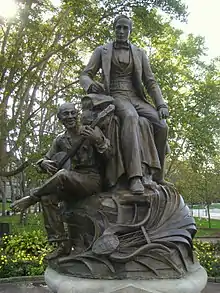
- A public sculpture by Giuseppe Moretti honoring Foster and commemorating his song "Uncle Ned" sat in close proximity to the Stephen Foster Memorial until 2018. The statue was removed following complaints about the banjo-playing slave seated next to Foster.[42]
- In Alms Park in Cincinnati, overlooking the Ohio River, there is a seated statue of him.
- The Hall of Fame for Great Americans in the Bronx, overlooking the Harlem River, has a bronze bust of him by artist Walter Hancock. Added in 1940, he is among only 98 honorees from 15 classes of distinguished men and women.
- In My Old Kentucky Home State Park in Bardstown, Kentucky, a musical, called The Stephen Foster Story has been performed since 1958. There is also a statue of him next to the Federal Hill mansion, where he visited relatives and which is the inspiration for My Old Kentucky Home. A painting by Howard Chandler Christy entitled, "Stephen Foster and the Angel of Genius" is on display in the park's art collection. The painting inspired Florence Foster Jenkins to author a tableau in which she personally plays the role of the angel depicted in Christy's painting. The scene was featured in the film Florence Foster Jenkins in 2016.
Accolades and honors

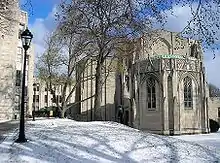
Foster is honored on the University of Pittsburgh campus with the Stephen Foster Memorial, a landmark building that houses the Stephen Foster Memorial Museum, the Center for American Music, as well as two theaters: the Charity Randall Theatre and Henry Heymann Theatre, both performance spaces for Pitt's Department of Theater Arts. It is the largest repository for original Stephen Foster compositions, recordings, and other memorabilia his songs have inspired worldwide.
Two state parks are named in Foster's honor: the Stephen Foster Folk Culture Center State Park in White Springs, Florida and Stephen C. Foster State Park in Georgia. Both parks are on the Suwannee River. Stephen Foster Lake at Mount Pisgah State Park in Pennsylvania is also named in his honor.
One state park is named in honor of Foster's songs, My Old Kentucky Home, an historic mansion formerly named Federal Hill, located in Bardstown, Kentucky where Stephen is said to have been an occasional visitor according to his brother, Morrison Foster. The park dedicated a bronze statue in honor of Stephen's work.
The Lawrenceville (Pittsburgh) Historical Society, together with the Allegheny Cemetery Historical Association, hosts the annual Stephen Foster Music and Heritage Festival (Doo Dah Days!). Held the first weekend of July, Doo Dah Days! celebrates the life and music of one of the most influential songwriters in America's history. His home in the Lawrenceville Section of Pittsburgh, Pennsylvania, still remains on Penn Avenue nearby the Stephen Foster Community Center.
A 1900 statue of Foster by Giuseppe Moretti was located in Schenley Plaza, in Pittsburgh, from 1940 until 2018. On the unanimous recommendation of the Pittsburgh Art Commission, the statue was removed on April 26, 2018.[43] Its new home has not yet been determined. It has a long reputation as the most controversial public art in Pittsburgh "for its depiction of an African-American banjo player at the feet of the seated composer. Critics say the statue glorifies white appropriation of black culture, and depicts the vacantly smiling musician in a way that is at best condescending and at worst racist."[44] A city-appointed Task Force on Women in Public Art called for the statue to be replaced with one honoring an African American woman with ties to the Pittsburgh community. The Task Force held a series of community forums in Pittsburgh to collect public feedback on the statue replacement and circulated an online form which allowed the public to vote for one of seven previously selected candidates or write in an alternate suggestion.[45] However, the Task Force on Women in Public Art and the Pittsburgh Art Commission have not reached an agreement as to who will be commemorated or if the statue will stay in the Schenley Plaza location.[46]
See also
- The Stephen Foster Collection and archive – Most primary sources related to his life, family and music have been retained by the University of Pittsburgh Library System as the Foster Hall Collection housed in the Stephen Foster Memorial. These materials were obtained from philanthropists, or donated by collectors or his heirs.
Notes
- His grandfather James Foster was an associate of John McMillan and a founding trustee of Canonsburg Academy, a predecessor institution to Jefferson College; his father William Barclay Foster attended Canonsburg Academy until age 16.[11]
References
- "Stephen C. Foster As Man and Musician, The Life Story of the Sweet Singer of Pittsburg Told by His Contemporaries and Comrades". The Pittsburg Press. September 12, 1900 – via Newspapers.com.

- Marks, Rusty (April 22, 2001), "ON TELEVISION: Stephen Foster: Quintessential songwriter lived in music, died in ruin", Sunday Gazette-Mail, Gazette Daily Inc. via HighBeam Research, archived from the original on October 11, 2013, retrieved April 25, 2012,
The song, written in 1847, soon spread throughout the country. Foster decided to become a full-time songwriter, a vocation no one had bothered to pursue until then.
(subscription required) - Pittsburgh Native Son and Songwriter Stephen Foster to be Inducted into Nashville Songwriters Hall of Fame Oct. 17., US Fed News Service, Including US State News. The Associated Newspapers of Ceylon Ltd. via HighBeam Research, October 16, 2010, archived from the original on October 11, 2013, retrieved April 25, 2012(subscription required)
-
Compare:
Root, Deane L. (March 12, 1990). "The 'Mythtory' of Stephen C. Foster or Why His True Story Remains Untold" (Lecture transcript at the American Music Center Research Conference). American Music Research Center Journal: 20–21. Retrieved December 24, 2019.
[... Stephen Foster ...] was the most famous songwriter of the nineteenth century, and he is still the best-known American composer in many countries of the world today.
- Root, Deane L. (March 12, 1990). "The 'Mythtory' of Stephen C. Foster or Why His True Story Remains Untold" (Lecture transcript at the American Music Center Research Conference). American Music Research Center Journal: 20–36. Retrieved October 4, 2015: Access provided by the University of Pittsburgh Library System
- Howard, John Tasker (March 1944). "The Literature on Stephen Foster". Notes: Quarterly Journal of the Music Library Association. 1 (2): 10–15. doi:10.2307/891301. ISSN 0027-4380. JSTOR 891301.
- Root, Deane L. (March 1990). "The "Mythtory" of Stephen C. Foster or Why His True Story Remains Untold" (PDF). American Music Research Center. U. Colorado, Boulder. Retrieved September 25, 2018.
- Sanders, Paul (Fall 2008). "Comrades, Fill No Glass For Me: Stephen Foster's Medlodies As Borrowed by the American Temperance Movement" (PDF). Social History of Alcohol and Drugs. 23 (1): 24–40. doi:10.1086/SHAD23010024. S2CID 165454878. Retrieved October 13, 2015.
- "Foster Hall Collection, Collection Number: CAM.FHC.2011.01, Guide to Archives and Manuscript Collections at the University of Pittsburgh Library System". University of Pittsburgh, Center for American Music. Retrieved October 13, 2015; Access provided by the University of Pittsburgh
- Emerson, Ken (1998). Doo-dah! Steven Foster and the Rise of American Popular Culture. Da Capo Press. p. 79. ISBN 978-0-306-80852-4.
- Vincent Milligan, Harold (1920). Stephen Collins Foster: a biography of America's folk-song composer. G. Schirmer. pp. 3–4.
- "Biography". The Center for American Music. Univ. of Pittsburgh. Retrieved September 25, 2018.
- Sisario, Ben (September 20, 1998). "ON THE MAP; Stephen Foster's Old Hoboken Home". The New York Times. Retrieved July 4, 2016.
- "American Experience | Stephen Foster | People & Events". Shoppbs.pbs.org. Retrieved January 8, 2021.
- Saunders (2012). "The Social Agenda of Stephen Foster's Plantation Melodies". American Music. 30 (3): 275–289. doi:10.5406/americanmusic.30.3.0275. JSTOR 10.5406/americanmusic.30.3.0275. S2CID 144617319.
- "More about the film Stephen Foster". American Experience. PBS. Retrieved October 2, 2015.
- O'Connell, JoAnne H. (2007). Understanding Stephen Collins Foster, His World and Music (PDF) (Thesis). University of Pittsburgh. Retrieved June 25, 2016.
- O'Connell, JoAnne (2016). The Life and Songs of Stephen Foster: a Revealing Portrait of the Forgotten Man Behind Swanee River, Beautiful Dreamer, and My Old Kentucky Home. Lanham, MD: Rowman and Littlefield. p. 321. ISBN 9781442253865.
- Emerson, Ken (2010). Stephen Foster and Co.: Lyrics of America's First Great Popular Songs. New York: Library of America. p. 10. ISBN 978-1598530704.
- W. Tomaschewski. "The Last Chapter". Stephen Collins Foster. W. Tomaschewski. Retrieved August 4, 2012.
- Barcousky, Len (February 14, 2016). "Eyewitness 1916: Living link to Foster passes on". Pittsburgh Post Gazette. Retrieved April 27, 2016.
- "Waters' Choral Harp: a new and superior collection of choice hymns and tunes, mostly new, written and composed for Sunday schools, missionary, revival, and social meetings, and for church worship 106. Who has our Redeemer heard". Hymnary.org. Retrieved August 23, 2016.
- "All around is bright and fair, While we work for Jesus". Hymnary.org. Retrieved August 23, 2016.
- "Blame not those who weep and sigh". Hymnary.org. Retrieved August 23, 2016.
- Steel, David Warren (2008). The New Encyclopedia of Southern Culture; Volume 12: Music; Foster, Stephen (1826–1864) COMPOSER AND SONGWRITER. University of North Carolina Press. JSTOR 10.5149/9781469616667_malone.86: Access provided by the University of Pittsburgh
- Whitburn, Joel, Top R&B Singles, 1942–1999, p. 74.
- "The State Anthem: "Florida (Where the Sawgrass Meets the Sky)"". State of Florida. Retrieved April 29, 2011.
- Burns, Ken. "Stephen Foster". American Experience. PBS. Retrieved August 23, 2016.
- "The Coon Character". Jim Crow Museum of Racist Memorabilia, Ferris State University. Retrieved November 9, 2011.
- John Kenrick. "A History of the Musical: Minstrel Shows". musicals101.com. 1996, revised 2003. Retrieved October 2, 2015.
- Behind the Burnt Cork Mask: Early Blackface Minstrelsy and Antebellum American Popular Culture by William J. Mahar. University of Illinois Press (1998). p. 9. ISBN 0-252-06696-0.
- Schwallie, Karen. "Greenfield Village Memories – Stephen Foster Home". Retrieved October 3, 2015.
- Wilkinson, Clint. " Stephen Foster House in Museum Wrong One". The Detroit Free Press. January 30, 1953. Access date October 2, 2015| Access provided by the University of Pittsburgh Library System
- Lowry, Patricia (March 30, 2003). "Theater: A dramatic makeover for the Stephen Foster Memorial". Retrieved October 25, 2015.
- Lerner, Neil (September 2006). "Review: Tunes for 'Toons': Music and the Hollywood Cartoon by Daniel Goldmark". Notes: Quarterly Journal of the Music Library Association. 63 (1): 121–124. JSTOR 4487739.
- "Stephen C. Foster's Blues". The Possum Trot Orchestra. Retrieved May 10, 2015.
- "E.M.A. – California Lyrics". SongLyrics. Retrieved August 4, 2012.
- A Source guide to the music of Percy Grainger. Lewis, Thomas P. (1st ed.). White Plains, N.Y.: Pro/Am Music Resources. 1991. ISBN 9780912483566. OCLC 24019532.CS1 maint: others (link)
- "What Is It All but Luminous by Art Garfunkel | PenguinRandomHouse.com: Books". PenguinRandomhouse.com. Retrieved April 25, 2019.
- Monger, James. "Wilderness - The Handsome Family". Allmusic.com. Retrieved July 8, 2013.
- "1-cent Foster". Arago: people, postage & the post, Smithsonian National Postal Museum. Retrieved May 10, 2015.
- "'Oh! Susanna' songwriter's statue removed from Pittsburgh park after criticism". NBC News. Retrieved April 25, 2019.
- "'Oh Susanna' songwriter's statue removed amid criticism". Associated Press. April 26, 2018. Retrieved April 26, 2018.
- Majors, Dan (October 25, 2017). "City's art commission unanimous: Statue of Stephen Foster needs to go". Pittsburgh Post-Gazette. Retrieved May 5, 2018.
- "City wants statue of African-American woman to replace Stephen Foster monument". Pittsburgh Post-Gazette. March 14, 2018. Retrieved September 16, 2018.
- O'Driscoll, Bill (July 2, 2018). "Initiative To Honor Women Of Color With Public Art Sparks Debate". WESA. WESA. Retrieved September 16, 2018.
Further reading
- Emerson, Ken, ed. (2010). Stephen Foster & Co.: Lyrics of the First Great American Songwriters. New York: The Library of America. ISBN 978-1-59853-070-4. OCLC 426803667.
- Hamm, Charles (1983). Yesterdays: Popular Song in America. New York City: W. W. Norton & Co. ISBN 978-0393300628.
- Hodges, Fletcher, Jr. (1939). A Pittsburgh Composer and His Memorial. Pittsburgh, Pennsylvania: Historical Society of Western Pennsylvania. ASIN B01A8YVHHM.
- Hodges, Fletcher, Jr. (1948). The Research Work of the Foster Hall Collection. Philadelphia: University of Pennsylvania Press.
- Hodges, Fletcher, Jr. (1958). The Swanee River and a Biographical Sketch of Stephen Collins Foster. Whitefish, Montana: Literary Licensing, LLC. ISBN 978-1258193980.
- Howard, John Tasker (March 1944). "The Literature on Stephen Foster". Notes: Quarterly Journal of the Music Library Association. 1 (2): 10–15. doi:10.2307/891301. JSTOR 891301.
- Howard, John Tasker (1945). Stephen Foster: America's Troubadour. New York City: Tudor Publishing Company. ASIN B0007ELPPI.
- Milligan, Harold Vincent (1920). Stephen Collins Foster: A Biography Of America's Folk-Song Composer. Whitefish, Montana: Kessinger Publishing, LLC. ISBN 978-0548971864.
- Morneweck, Evelyn (1973). Chronicles of Stephen Foster's Family. Associated Faculty Press, Inc. ISBN 978-0804617420.
- O'Connell, JoAnne (2016). The Life and Songs of Stephen Foster: a Revealing Portrait of the Forgotten Man Behind Swanee River, Beautiful Dreamer, and My Old Kentucky Home. Lanham, MD: Rowman and Littlefield. p. 321. ISBN 9781442253865.
- "Foster Hall Collection". Center for American Music; University of Pittsburgh. Retrieved March 24, 2017.
- "Pictorial Biography of Stephen Collins Foster" (PDF). Musical Courier. 1930. Retrieved March 24, 2017.
External links
- Free scores by Stephen Foster at the International Music Score Library Project (IMSLP)
- Works by or about Stephen Foster at Internet Archive
- Stephen Foster at IMDb
- Stephen Foster at Find a Grave
- Archives of Stephen Foster at the University of Kentucky
- Stephen Foster discography at Discogs
- Pittsburgh Music History
- Hymns and songs by Stephen Foster
- Stephen Collins Foster recordings at the Discography of American Historical Recordings.
Music scores
- Sheet music for "I see her still in my dreams", Macon, GA: John C. Schreiner & Son, from the Confederate Imprints Sheet Music Collection
- Sheet music for "Parthenia to Incomar", Macon, GA: John C. Schreiner & Son, from the Confederate Imprints Sheet Music Collection
- "The Melodies of Stephen C. Foster" (online version) Pittsburgh, PA: T.M. Walker, Full sheet music book, 307 pages
